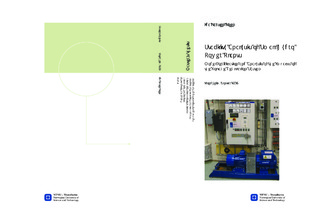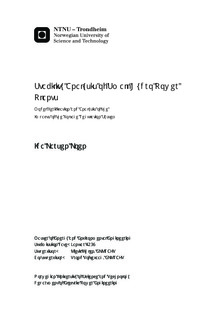| dc.description.abstract | This master thesis concerns stability problems and protection related to small hydro distributed generation. Behavior related to the voltage regulator and the excitation limiters is the main focus in this report. The report consists of two main parts. Part one concerns laboratory studies with focus on the characteristics of the laboratory model, and system modeling and validation. In the other part of the thesis, the validated model is used to study the effect of the excitation limiters and their influence on the system response and performance. These studies are useful to obtain knowledge considering operation close to the power system limits.The laboratory model considered in this thesis is a motor-generator set in the NTNU/SINTEF renewable energy laboratory, representing a small hydro power plant. The characteristics of this model are studied through laboratory measurements, and the system is modeled in Simulink and validated by laboratory testing. The final simulation model of the laboratory system has a response very similar to the actual model. The response of the simulation model has some deviations from the laboratory model, but these are considered small and it is concluded that the model is valid for further studies of excitation limiters for these master thesis.Studies and measurements in the laboratory have given important information about the model and its characteristics and performance. The motor drive operating as a turbine governing system for the laboratory model does not seem to give a realistic representation of a hydraulic turbine governing system. The motor drive responds fast and efficient to disturbances, and contributes greatly to a well damped system with a high stability margin. The motor drive should respond more slowly to give a more realistic representation of the relatively slow response of hydro turbine governors. The excitation system parameters have a great influence on the behavior of the synchronous generator in the laboratory model. The details concerning the excitation system structure are partly unknown, which makes it challenging to find the exact parameters for the voltage regulator implemented in the Simulink model. The parameters found through studying the simulated response seems to be satisfying, as the voltage response of the simulation model is regulated similarly as for the laboratory model. For the cases evaluated in this report, the laboratory model seems to have better small signal stability characteristics when operating underexcited. Whether the stability margin is higher for under- or overexcited operation seems to depend on the characteristics of the generator.The dynamic field current limiters implemented in the simulation model seem to be a close representation of the excitation limiters in the laboratory model. The limiters, controlled by PI controllers are activated as the field current has exceeded a given limit for a certain amount of time. The field current response in field current limiting operation mode depends on the proportional- and integral gain of the PI controller. It is shown that changes of these parameters affect the response significantly. Further studies are needed to draw any conclusions if, and for which cases, this can provoke instability when the field current limiters are activated. | nb_NO |

